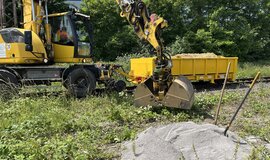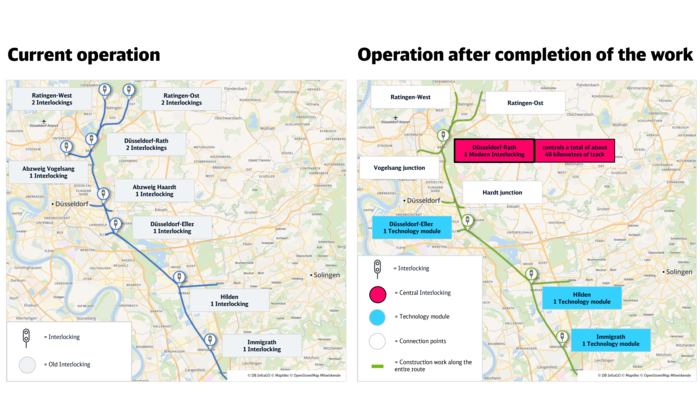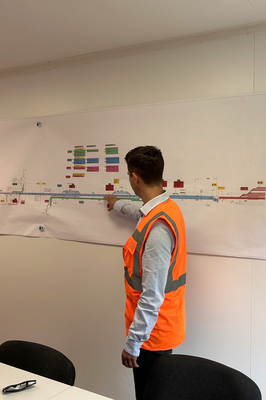
Construction work in full swing since March: Deutsche Bahn modernises interlocking technology in the Rhineland
The outdated interlocking technology on the approximately 40-kilometre-long railway line between Ratingen, Düsseldorf, Hilden and Immigrath is being fundamentally modernised. The EU, the federal government and Deutsche Bahn are jointly investing over 200 million euros in this project – with the clear aim of making rail transport in the Rhineland more reliable, punctual and future-proof.
As part of the modernisation, a total of eleven old interlockings with mechanic or relay-based technology will be replaced by modern, digital interlocking technology. To this end, a new central interlocking is being built in Düsseldorf-Rath, from which all train traffic on the approximately 40-kilometre section of line will be controlled in future. The previous lever banks and outdated buttons will give way to modern workstations where signallers will control train traffic using a monitor, keyboard and mouse. In addition, three technology modules are being built along the line in Düsseldorf-Eller, Hilden and Immigrath. These are directly connected to the central interlocking and act as its technical extension. The new technology not only enables modern control and operation but is also significantly less prone to faults. This leads to greater reliability, punctuality and efficiency on the busy line.

The main work has been underway since March. In addition to the new interlocking and its three technology modules, numerous other construction measures are required, in particular the installation or relocation of:
- 470 new signals and 11 new signal brackets,
- 560 kilometres of cable and 55 kilometres of cable ducts,
- 4 new points connections at Ratingen West, Düsseldorf-Eller Mitte, Düsseldorf-Eller & Hilden stations,
- 4 new point heating systems and
- 2 new track area lighting systems.
The new points connections not only make it possible to set up track-change operations, but also significantly improve the flexibility of the route options. This means that trains can be diverted to other routes if necessary – for example in the event of disruptions on the busy line between Düsseldorf and Cologne. The modernised line then takes on the function of an efficient alternative route.
Despite the huge scope of construction, over 50 per cent of the work is to be completed within six months. Several track possessions are planned on the route until December 2025. This will allow many measures to be bundled and carried out in parallel, which will save a significant amount of time for the project team and passengers. Information on the line closures and passenger transport restrictions can be found at zuginfo.nrw.
DB is also using the construction phase to carry out further targeted improvements along the lines:
- In Hilden, the platform roof will be completed and the equipment renewed.
- In Düsseldorf-Eller Mitte, the platform will be extended.
- In Oberbilk, preparations are starting for a barrier-free extension.
- Eight additional OLE masts will increase the load capacity of the line.
Construction work is already in full swing. Today, on 11 June 2025, representatives of the regional press had the opportunity to experience the progress first-hand during a site inspection at Hilden station. On site, project managers Christian Walge and Ulrich Konopka provided information about the current status and the next steps in the construction work.

"It is important to us to create transparency and show how we are using the measures to make the infrastructure more reliable again in the long term," emphasised Christian Walge, Project Manager, DB InfraGO AG, during the inspection.
However, the project is not only focussed on reducing disruption on the line. The modernisation measures in the Rhineland also create the prerequisites for equipping the line with the European Train Control System (ETCS). The affected section between Ratingen, Düsseldorf, Hilden and Immigrath is located on the Corridor Rhine-Alpine – one of the most important north-south connections in Europe, linking central seaports and economic areas in the Netherlands, Belgium, Germany, Switzerland and Italy.
Germany is obliged to fully equip its approximately 1,400 kilometre-long section of the corridor with ETCS by 2040. The renewal of the interlocking technology in the Rhineland represents an important technical gap closure in this context, as the Corridor Rhine-Alpine is already largely equipped with the modern interlocking technology that is a prerequisite for ETCS.
ETCS will ultimately gradually replace the different national train control systems in the EU and thus enable continuous cross-border train traffic without a transition. This will sustainably increase reliability and interoperability on the European rail network.

